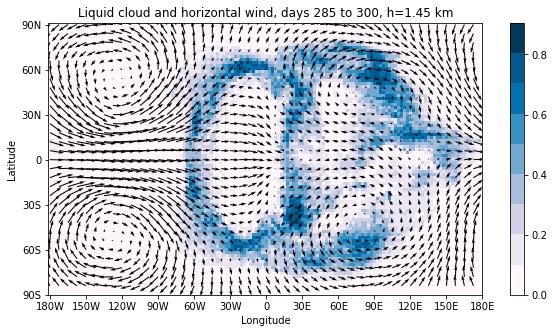Weather patterns on Earth-like exoplanets could affect observations
Most potentially habitable rocky planets are expected to be in tidally locked orbits around small, cool stars. Just as the Moon always shows the same face to the Earth, these planets always have the same hemisphere facing their star.
They do not experience day and night and, if they have little to no obliquity or eccentricity, they do not experience seasons, either. In spite of this, global climate simulations show that these planets still experience periodic atmospheric variability because of intrinsic feedback loops between clouds and wind patterns.

We discovered an oscillation in cloud cover and wind structure in a simulation of a temperate rocky planet based on Proxima Centauri b. To study the causes of this oscillation, we ran four simulations of tidally locked planets with moist atmospheres and different equilibrium temperatures and rotation rates and one additional simulation of a planet with a dry atmosphere. We found that changes in the amount of cloud on the planet’s dayside affect the speed of the zonal winds, which determine the longitude of massive atmospheric gyres in the northern and southern hemispheres. As the zonal wind speed changes, the position of the gyres shifts back and forth by around 100 degrees longitude.
The gyre position in turn affects how much cloud is carried from the substellar region on the dayside to the eastern terminator. When the gyres are located at the westernmost edge of their range, they circulate cloud from the substellar region towards the midlatitudes and then east towards the terminator. As the gyres shift eastwards themselves, they no longer intersect with the cloudy region at the centre of the planet’s dayside and so no longer carry cloud cover towards the limb. This oscillation results in a regular pattern of cloudy and clear conditions at the eastern terminator. The oscillation occurred in all four simulations with moist atmospheres (and therefore clouds), but not in the simulation with a dry atmosphere.
To test whether this oscillation could affect observations of a planet through transmission spectroscopy, we generated transmission spectra for 300 days of each simulation. We selected one water vapour absorption feature and one carbon dioxide absorption feature from the spectra and plotted their transit depth over the 300-day period. For two of our simulations, in which the atmospheric gyres formed at mid-latitudes and interacted with the region of cloud cover, the time series showed variations in transit depth with the same period as the oscillation in the cloud cover at the limb. In two other simulations, the gyres formed at high latitudes beyond the extent of the dayside cloud cover, and the time series showed only random variation without periodicity.
The difference in the size of the transit features was too small to be detectable by current methods. However, this study shows that weather conditions on exoplanets could affect observations. As in remote sensing of the Earth, there will be clear periods in which it may be easier to obtain good quality spectra, and cloudy periods in which observing is fruitless.
This study was published in Cohen et al. 2023. The Planetary Science Journal, 4, 68, doi: 10.3847/PSJ/acc9c4 (https://iopscience.iop.org/article/10.3847/PSJ/acc9c4).

